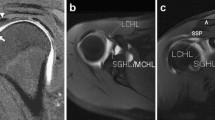Abstract
Objective
To determine the effect of patient age on the accuracy of primary MRI signs of long head of biceps (LHB) tendon tearing and instability in the shoulder using arthroscopy as a reference standard.
Materials and methods
Subjects with MRI studies and subsequent arthroscopy documenting LHB tendon pathology were identified and organized into three age groups (18–40, 41–60, 61–87). Normal and tendinopathic tendons were labeled grade 0, partial tears grade 1 and full tears grade 2. Two radiologists blinded to arthroscopic data graded MRI studies independently. Prevalence of disease, MRI accuracy for outcomes of interest, and inter-reader agreement were calculated.
Results
Eighty-nine subjects fulfilled inclusion criteria with 36 grade 0, 36 grade 1 and 17 grade 2 tendons found at arthroscopy. MRI sensitivity, regardless of age, ranged between 67–86% for grade 0, 72–94% for grade 1 and 82–94% for grade 2 tendons. Specificity ranged between 83–96% for grade 0, 75–85% for grade 1 and 99–100% for grade 2 tendons. MRI accuracy for detection of each LHB category was calculated for each age group. MRI was found to be least sensitive for grade 0 and 1 LHB tendons in the middle-aged group with sensitivity between 55–85% for grade 0 and 53–88% for grade 1 tendons. Agreement between MRI readers was moderate with an unweighted kappa statistic of 62%.
Conclusion
MRI accuracy was moderate to excellent and agreement between MRI readers was moderate. MRI appears to be less accurate in characterizing lower grades of LHB tendon disease in middle-aged subjects.







Similar content being viewed by others
References
Murthi AM, Vosburgh CL, Neviaser TJ. The incidence of pathologic changes of the long head of the biceps tendon. J Shoulder Elb Surg. 2000;9(5):382–5.
Khazzam M, et al. Disorders of the long head of biceps tendon. J Shoulder Elb Surg. 2012;21(1):136–45.
Ben Kibler W, et al. Clinical utility of traditional and new tests in the diagnosis of biceps tendon injuries and superior labrum anterior and posterior lesions in the shoulder. Am J Sports Med. 2009;37(9):1840–7.
Buck FM, et al. Degeneration of the long biceps tendon: comparison of MRI with gross anatomy and histology. AJR Am J Roentgenol. 2009;193(5):1367–75.
Zanetti M, et al. Tendinopathy and rupture of the tendon of the long head of the biceps brachii muscle: evaluation with MR arthrography. AJR Am J Roentgenol. 1998;170(6):1557–61.
Razmjou H, et al. Accuracy of magnetic resonance imaging in detecting biceps pathology in patients with rotator cuff disorders: comparison with arthroscopy. J Shoulder Elb Surg. 2016;25(1):38–44.
Dubrow SA, et al. Diagnostic accuracy in detecting tears in the proximal biceps tendon using standard nonenhancing shoulder MRI. Open Access J Sports Med. 2014;5:81–7.
Polster JM, Schickendantz MS. Shoulder MRI: what do we miss? AJR Am J Roentgenol. 2010;195(3):577–84.
Sowa D, et al. Preferential sites for rupture of the long head of the biceps tendon. Z Orthop Ihre Grenzgeb. 1995;133(6):568–72.
Carr RM, Shishani Y, Gobezie R. How accurate are we in detecting biceps tendinopathy? Clin Sports Med. 2016;35(1):47–55.
Tadros AS, et al. Long head of the biceps brachii tendon: unenhanced MRI versus direct MR arthrography. Skelet Radiol. 2015;44(9):1263–72.
Buck FM, et al. Long biceps tendon: normal position, shape, and orientation in its groove in neutral position and external and internal rotation. Radiology. 2011;261(3):872–81.
Gaskin CM, et al. Anomalies of the long head of the biceps brachii tendon: clinical significance, MR arthrographic findings, and arthroscopic correlation in two patients. Skelet Radiol. 2007;36(8):785–9.
Spritzer CE, et al. Assessment of instability of the long head of the biceps tendon by MRI. Skelet Radiol. 2001;30(4):199–207.
Schaeffeler C, et al. Lesions of the biceps pulley: diagnostic accuracy of MR arthrography of the shoulder and evaluation of previously described and new diagnostic signs. Radiology. 2012;264(2):504–13.
Urita A, et al. Predictive factors of long head of the biceps tendon disorders-the bicipital groove morphology and subscapularis tendon tear. J Shoulder Elb Surg. 2016;25(3):384–9.
Habermeyer P, et al. Anterosuperior impingement of the shoulder as a result of pulley lesions: a prospective arthroscopic study. J Shoulder Elb Surg. 2004;13(1):5–12.
Baratloo A, et al. Part 1: Simple definition and calculation of accuracy, sensitivity and specificity. Emerg (Tehran). 2015;3(2):48–9.
McGee S. Simplifying likelihood ratios. J Gen Intern Med. 2002;17(8):646–9.
Pinto A, Brunese L. Spectrum of diagnostic errors in radiology. World J Radiol. 2010;2(10):377–83.
Beall DP, et al. Association of biceps tendon tears with rotator cuff abnormalities: degree of correlation with tears of the anterior and superior portions of the rotator cuff. AJR Am J Roentgenol. 2003;180(3):633–9.
Houtz CG, et al. Shoulder MRI accuracy in the community setting. J Shoulder Elb Surg. 2011;20(4):537–42.
Halma JJ, et al. Interdisciplinary inter-observer agreement and accuracy of MR imaging of the shoulder with arthroscopic correlation. Arch Orthop Trauma Surg. 2012;132(3):311–20.
Mohtadi NG, et al. A prospective, double-blind comparison of magnetic resonance imaging and arthroscopy in the evaluation of patients presenting with shoulder pain. J Shoulder Elb Surg. 2004;13(3):258–65.
Taylor SA, O’Brien SJ. Clinically relevant anatomy and biomechanics of the proximal biceps. Clin Sports Med. 2016;35(1):1–18.
Virk MS, Cole BJ. Proximal biceps tendon and rotator cuff tears. Clin Sports Med. 2016;35(1):153–61.
Braun S, et al. Lesions of the biceps pulley. Am J Sports Med. 2011;39(4):790–5.
Patzer T, et al. Is there an association between SLAP lesions and biceps pulley lesions? Arthroscopy. 2011;27(5):611–8.
Streit JJ, et al. Tendinopathy of the long head of the biceps tendon: histopathologic analysis of the extra-articular biceps tendon and tenosynovium. Open Access J Sports Med. 2015;6:63–70.
Struhl S. Anterior internal impingement: an arthroscopic observation. Arthroscopy. 2002;18(1):2–7.
Acknowledgements
We would like to thank Victoria Cain for her assistance in preparation of the manuscript.
Author information
Authors and Affiliations
Corresponding author
Ethics declarations
Conflict of interest
The authors declare that they have no conflict of interest.
Rights and permissions
About this article
Cite this article
Borrero, C.G., Costello, J., Bertolet, M. et al. Effect of patient age on accuracy of primary MRI signs of long head of biceps tearing and instability in the shoulder: an MRI-arthroscopy correlation study. Skeletal Radiol 47, 203–214 (2018). https://doi.org/10.1007/s00256-017-2783-6
Received:
Revised:
Accepted:
Published:
Issue Date:
DOI: https://doi.org/10.1007/s00256-017-2783-6




